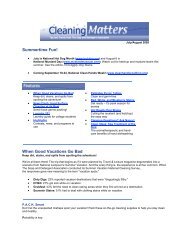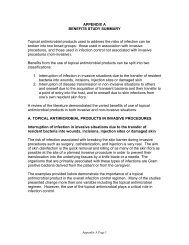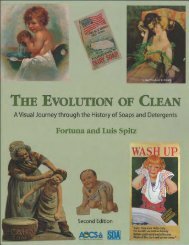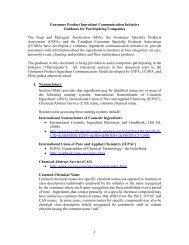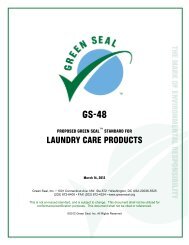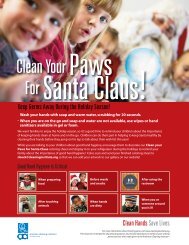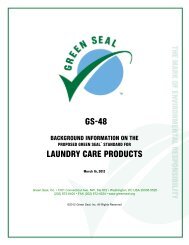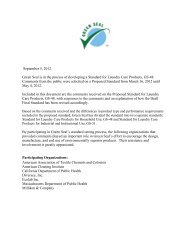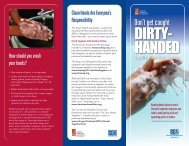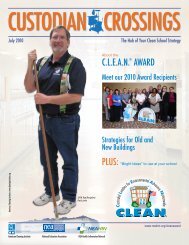subchapter c -- federal hazardous substances act regulations
subchapter c -- federal hazardous substances act regulations
subchapter c -- federal hazardous substances act regulations
Create successful ePaper yourself
Turn your PDF publications into a flip-book with our unique Google optimized e-Paper software.
uises, or other injuries to fingers, toes, or<br />
other parts of the anatomy of young children.<br />
Included among, but not limited to, the design<br />
features of such articles which classify the<br />
articles as banned <strong>hazardous</strong> <strong>substances</strong> are:<br />
(i) The areas about the point on each side<br />
of the article where the frame components are<br />
joined together to form an “X” shape capable<br />
of producing a scissoring, shearing, or<br />
pinching effect.<br />
(ii) Other areas where two or more parts<br />
are joined in such a manner as to permit a<br />
rotational movement capable of exerting a<br />
scissoring, shearing, or pinching effect.<br />
(iii) Exposed coil springs which may<br />
expand sufficiently to allow an infant’s finger,<br />
toe, or any other part of the anatomy to be<br />
inserted, in whole or in part, and injured by<br />
being caught between the coils of the spring or<br />
between the spring and another part of the<br />
article.<br />
(iv) Holes in plates or tubes which provide<br />
the possibility of insertion, in whole or in part,<br />
of a finger, toe, or any part of the anatomy that<br />
could then be injured by the movement of<br />
another part of the article.<br />
(v) Design and construction that permits<br />
accidental collapse while in use. (But see §<br />
1500.86(a)(4)).<br />
(7) Toys usually known as clacker balls<br />
and consisting of two balls of plastic or<br />
another material connected by a length of line<br />
or cord or similar connector (referred to as<br />
“cord” in § 1500.86(a)(5)), intended to be<br />
operated in a rhythmic manner by an upward<br />
and downward motion of the hand so that the<br />
two balls will meet forcefully at the top and<br />
bottom of two semicircles thus causing a<br />
“clacking” sound, which toys present a<br />
mechanical hazard because their design or<br />
manuf<strong>act</strong>ure presents an unreasonable risk of<br />
personal injury from fr<strong>act</strong>ure, fragmentations,<br />
or disassembly of the toy and from propulsion<br />
of the toy or its part(s). (But see §<br />
1500.86(a)(5).) This does not include products<br />
that are constructed so that the connecting<br />
members consist of plastic rods integrally<br />
molded to the balls and are mounted on a pivot<br />
so that movement of the balls is essentially<br />
limited to a single plane.<br />
(8) Any pacifier that does not meet the<br />
requirements of 16 CFR part 1511 and that is<br />
introduced into interstate commerce after<br />
February 26, 1978.<br />
16 CFR Ch. II (1–1–05 Edition)—proposed modificication – 6/25/06<br />
-- 27 --<br />
(9) Any toy or other article intended for<br />
use by children under 3 years of age which<br />
presents a choking, aspiration, or ingestion<br />
hazard because of small parts as determined by<br />
part 1501 of this chapter and which is<br />
introduced into interstate commerce after<br />
January 1, 1980. For purposes of this<br />
regulation, introduction into interstate<br />
commerce is defined as follows: A toy or<br />
children’s article manuf<strong>act</strong>ured outside the<br />
United States is introduced into interstate<br />
commerce when it is first brought within a<br />
U.S. port of entry. A toy or children’s article<br />
manuf<strong>act</strong>ured in the United States is<br />
introduced into interstate commerce (1) at the<br />
time of its first interstate sale, or (2) at the time<br />
of its first intrastate sale if one or more of its<br />
components and/or raw materials were<br />
received interstate, whichever occurs earlier.<br />
Part 1501 defines the term “toy or other article<br />
intended for use by children under 3,” as used<br />
in this regulation, and exempts certain<br />
products from banning under this regulation.<br />
(10) – (11) [Reserved]<br />
(12) Any bicycle as defined in §<br />
1512.2(a) of this chapter (except a bicycle that<br />
is a “track bicycle” or a “one-of-a-kind<br />
bicycle” as defined in § 1512.2 (d) and (e) of<br />
this chapter) that is introduced into interstate<br />
commerce on or after May 11, 1976, and that<br />
does not comply with the requirements of part<br />
1512 of this chapter, except for §§<br />
1512.5(c)(3), 1512.9(a), 1512.18(e) and<br />
1512.18(f) which become effective November<br />
13, 1976.<br />
(13) Any full-size baby crib (as defined<br />
in § 1508.1(a) of this chapter) that is<br />
introduced into interstate commerce on or after<br />
February 1, 1974, and that does not comply<br />
with the requirements of §§ 1508.2 through<br />
1508.10 of this chapter; and any full size baby<br />
crib (as defined in § 1508.1(a) of this chapter)<br />
that is manuf<strong>act</strong>ured on or after April 27,<br />
1983, and that does not comply with §§ 1508.2<br />
through 1508.11 of this chapter.<br />
(14) Any non-full-size baby crib (as<br />
defined in § 1509.2 of this chapter) that is<br />
introduced into interstate commerce after<br />
August 9, 1976, and that does not comply with<br />
the requirements of §§ 1509.3 through<br />
1509.12 of this chapter; and any non-full size<br />
baby crib (as defined in § 1509.2 of this<br />
chapter) that is manuf<strong>act</strong>ured on or after April



